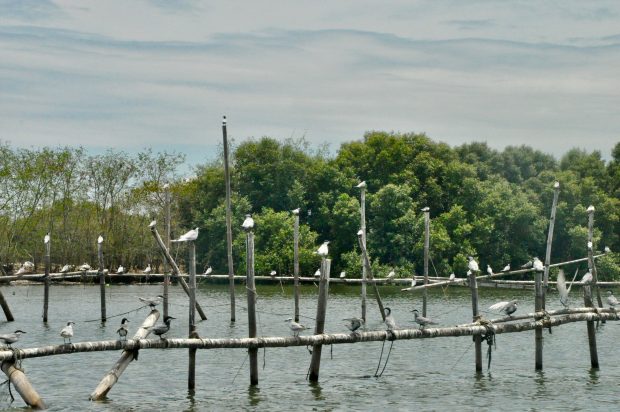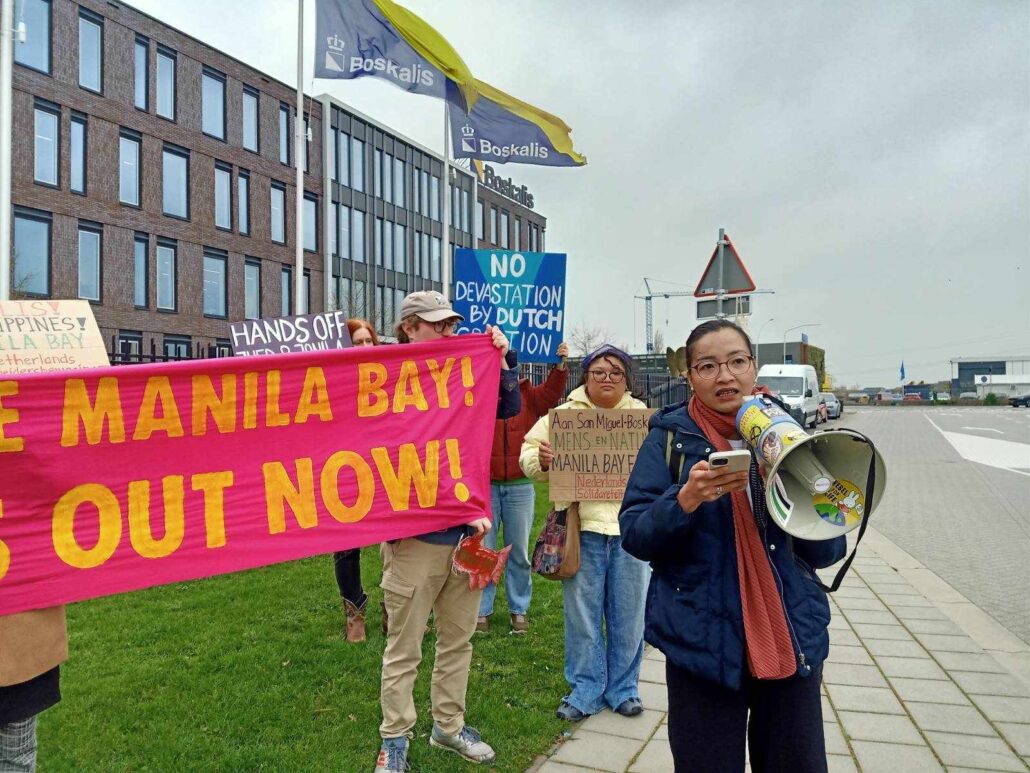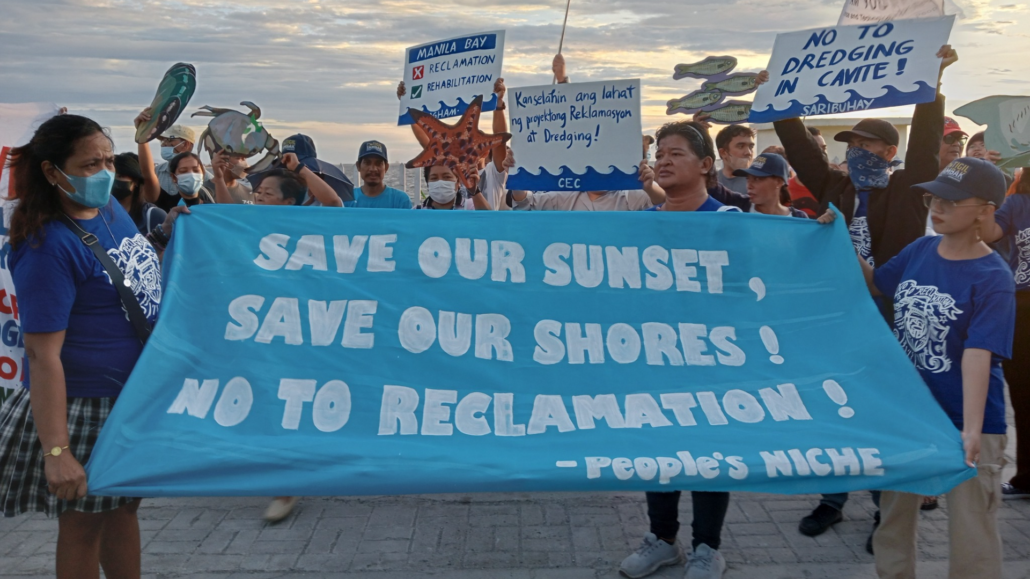Netherlands asked to probe Dutch corporate abuse in Bulacan airport project
Environmental groups held a rally in front of the The Netherlands Embassy in Makati last Friday, March 22, to demand accountability for two Dutch company’s involvement in the San Miguel Corporation’s P735-billion New Manila International Airport (NMIA) project on Manila Bay.
Environmental organizations and science advocates joined representatives of the group Defend Manila Bay from Cavite, Bulacan and Metro Manila coastal and fishing communities to protest what they call as an environmentally destructive reclamation project.
The protesters said that the NMIA project gained approval through intimidation of communities.
“Dutch company Boskalis Westminster NV stands to profit from the Philippines mega-airport, even as it is devastating the lives of our local fishing and coastal communities and our marine and coastal environment as well,” Jonila Castro, Kalikasan People’s Network for the Environment’s Advocacy Officer for Reclamation and Water, said.
Castro, also a member of Defend Manila Bay, is one of two young environmentalists who revealed their abduction by the Philippine Army and the National Task Force to End Local Communist Armed conflict in September last year.
READ: Environmentalists reveal abduction by military
Defend Manila Bay said the Dutch dredging giant Boskalios signed a €1.5 billion contract to construct the first phase of the NMIA in 2018, a project that is about the size of Makati City itself.
Boskalis is also extracting materials from the coastlines of Cavite province for back-fill material for the land reclamation process required to build the mega airport located in the territory of Bulacan province across the bay.
“Boskalis is profiting from a project that bypassed environmental and social scrutiny, ignored warnings from impact assessments, and, worst, used military intimidation to coerce ‘consent’ from affected communities. If this is not grave corporate abuse, then what is?” Bulacan community organizer Jhed Tamano asked.
Tamano is Castro’s co-survivor in the military’s abduction and fake-surrender fiasco.
“Soldiers had arrived every day, intimidating the community in Taliptip, Bulacan, threatening the residents that something bad might happen to them if they continued to refuse to leave. They did this until most of the 700 families in the coastal communities there were forced to leave their homes and agree to unjust compensation offers,” Tamano revealed.
READ: Saving Taliptip
‘Chilling norm’
Environmental Defenders Congress leader and Asia Pacific Network of Environment Defenders convenor Lia Torres said Castro and Tamano’s abduction is one of the many attacks suffered by environment defenders under the Ferdinand Marcos Jr. government.
“Jhed and Jonila’s abduction by soldiers is a becoming chilling norm under Marcos Jr.’s reign, emblematic of the militarization targeting communities opposing environmental devastation,” Torres said.
“Under the Marcos Jr. administration, 21 abduction incidents involving state forces targeting 38 individuals occurred, with 14 cases involving defenders. Twenty-one remain missing,” Torres added.
In February 2023, an investigative report by London-based Global Witness revealed that residents of Taliptip, Bulacan, disclosed that SMC sought approval for an unspecified “land development” rather than the massive airport project.
“This blatant lack of transparency robbed communities of their right to assess the project’s impacts and challenge any resulting harms,” Castro said.

Kalikasan further revealed that in addition to the displacement of communities from Bulacan, communities across the Manila Bay in Cavite province have also reported loss of livelihood and destruction of the environment.
The group said dredging operations by Boskalis cause dwindling fish catch and increasing cases of hunger by fishing families.
Dutch credit company also accountable
READ: Groups press call to save Manila Bay from reclamation projects
The protest rally also demanded accountability from the Dutch export credit agency Atradius Dutch State Business that provided at least 1.5 billion euros in export credit insurance to Boskalis for the NMIA project.
Boskalis obtained insurance for the project from the Dutch state through Atradius DSB in May 2022, it said.
“Despite opposition from local communities and civil society groups in both the Netherlands and the Philippines, the application was approved in 2022 by Atradius DSB and Dutch state secretary for finance Marnix van Rij,” Castro said.
The move contradicts the Netherlands’ government’s own environmental and corporate social responsibility (CSR) goals, she added.
Manila Bay wetlands in trouble
The NMIA project has also sparked significant controversy for its destruction of vital wetlands hosting diverse wildlife, including endangered migratory birds, the protesters said.
“Manila Bay is an internationally recognized biodiversity hotspot, and the airport development is set to destroy protected ecosystems in the area,” Jerwin Baure, a marine scientist of Advocates of Science and Technology for the People said.
The construction also encroaches upon a recommended ‘strict protection zone’ identified by a joint study of the Philippine and Dutch states, the scientist said.
“The construction will cause irreversible harm to the natural habitats in the area. As Manila Bay is a productive fishing ground, many fishers will lose their livelihoods. With mangroves being cut down, we also lose their ecosystem function of sequestering carbon from the atmosphere, helping to mitigate climate change,” Baure said.
“It’s puzzling that Dutch companies are involved in this harmful reclamation project, given their collaboration with Philippine authorities on the Manila Bay Sustainable Development Master Plan (MBSDMP) from 2018 to 2020, which received hundreds of millions of pesos worth of funding from the Dutch government, he added.
The protesters said they urge The Netherlands government to investigate corporate abuses by the Dutch companies and to ask the Philippine government to halt the airport project.

Dutch and Filipino environmentalists also held a parallel protest rally in Papendrecht, The Netherlands, Boskalis WMV’s headquarters.
They said the two rallies are the first of a series of globally coordinated actions against reclamation projects on Manila Bay.
READ: Groups demand scrapping of all Manila Bay reclamation projects
Last year, President Marcos ordered the suspension of all but one of the projects but environmental groups decried that reclamation have nonetheless continued. # (Raymund B. Villanueva)


